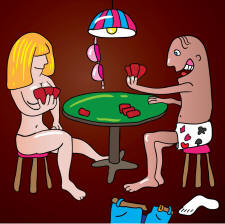Heads Up Poker Tournament Guide
 Heads up tournaments are quite different from normal poker tournaments. Instead of sitting at a table with eight or nine other players, you sit at a table with only one other player, playing each other "heads up". Also, heads up tournaments are almost always played in "match form", which basically means every player is put into a large bracket, and the winners of each match advance in the bracket.
Heads up tournaments are quite different from normal poker tournaments. Instead of sitting at a table with eight or nine other players, you sit at a table with only one other player, playing each other "heads up". Also, heads up tournaments are almost always played in "match form", which basically means every player is put into a large bracket, and the winners of each match advance in the bracket.
At the start of a heads up tournament, you are placed at a heads up table with one other player. You play each other heads up until one man has all the chips, and then the winner waits for the other matches to be done so everyone can move on to the next round.
Every set of matches will eliminate half of the tournament field, so if the tournament started with 128 players, the first round would begin with each player playing in a heads-up match until one of the two is defeated. The winning player would then sit on break until all other tables have one player left. This means the next round would begin with 64 players, then to 32, 16, 8, 4, and the final two players. Pay outs usually will begin with just over 15 percent of the tournament field left in play. So if there were 128 players to begin the tournament, payouts would begin when the tournament reached the third stage, or 16 players remaining.
Now we will discuss how to win a heads up poker tournament:
Opponent's Style of Play
The most important factor in your heads-up match is your opponent's style of play. The way you play your chip stack is decided by the way your opponent plays his. You must make your opponent uncomfortable in situations and always be pressuring him or her with tough decisions, which is exactly what players do not want. If you control your opponent in the match, then you will have no trouble winning the majority of heads-up matches.
If your opponent shows passive/tight tendencies then you must adapt accordingly. The best strategy against a tight player is to loosen your play and put pressure on him or her. This pressure can be brought out in a few different ways. Begin with pre-flop raises whenever possible, and continuation bets on the flop when the flop is dangerous. These types of bets will deter tight players from continuing in the hand, unless they have made significant improvement on the flop. Tight players are very likely to slow play hands as well, so if your continuation bet is indeed called on the flop, be careful of double-barreling the turn, as you may be falling into a trap.
Loose players are slightly more dangerous players to play against, mainly because you are never positive what type of hand they hold. These players can and will play any hand as if it has great value before or after the flop. The best method for playing one of these opponents is to slightly tighten up.
Avoid pre-flop raises with marginal hands because you are likely to be called very often, and should only enter a pre-flop raised pot with a strong hand. Re-raises are very effective against these players in two ways, usually because aggressive players will realize when they are playing against a tighter player and surrender their hands to large re-raises. Re-raising in the big blind pre-flop and check raising the flop may be very effective in winning fairly large pots without having to move to a showdown.
Position
Position is also one of the most important factors in a heads-up hand. The dealer position is always far better for two reasons: You can raise preflop to steal the blinds, and are second to act after the flop (in position). The 2.5x raise pre-flop with marginal hands is very valuable in this case because it is not a large portion of your like as a 4x raise would be, but is still enough to make the big blind surrender his or her hand if they have rags.
The big blind is slightly more difficult to play because you are likely to be put under pressure as well. Holding any hand such as Ax, K10, QJ is significant enough for a re-raise in this position. This is because you are not only heads up (which makes these hands very strong), but your opponent is likely to raise you with any hand.
Stack Size
Stack size is very important to consider along with your position and your opponent's style of play. Having the big stack will give you the chance to be very aggressive with your opponent. Although you may have been slightly uncomfortable raising often in the dealer position with an average stack, the big stack should give you confidence to steal blinds more often with weaker hands.
The smaller stack is actually a simpler stack to play because your moves are limited. You are likely to be pressured every hand in the big blind, and your only option in this case may be to re-raise all in. A short stack is considered at or less than 10 bb's, and re-raising with hands such as Ax, K9, and Q10 are sure moves in this position.
